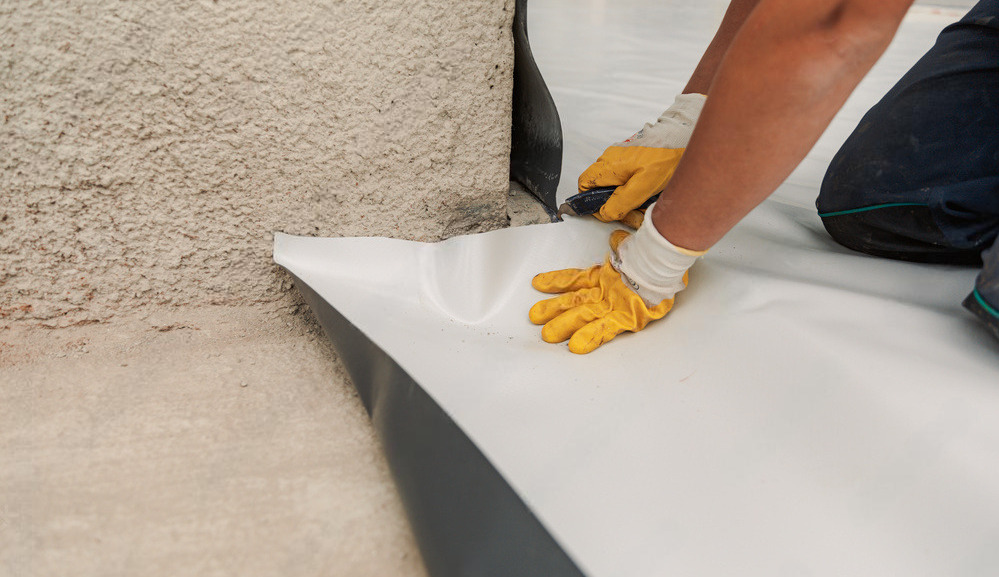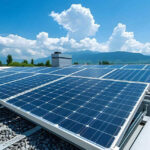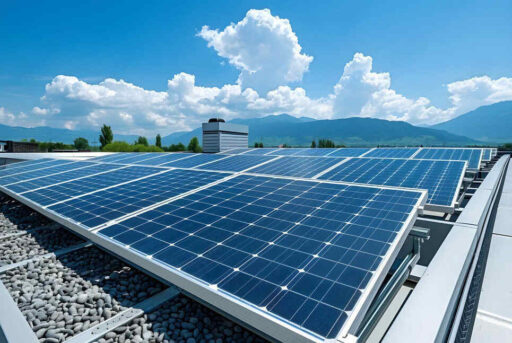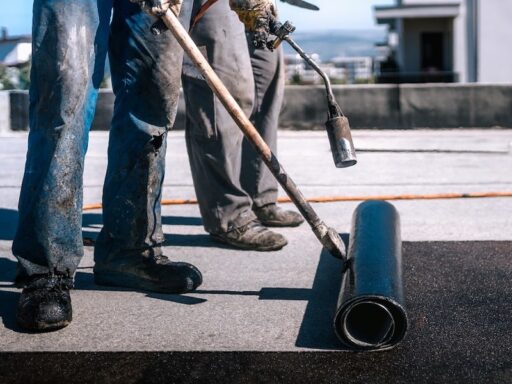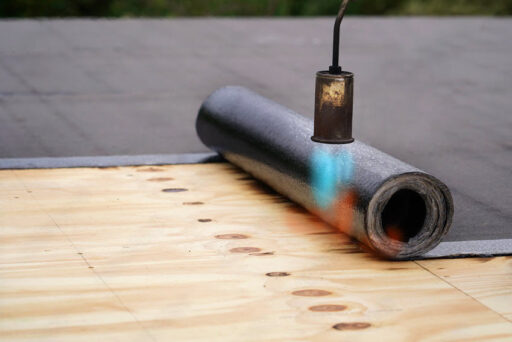You might’ve heard about TPO roofing and asked yourself, “What’s TPO roofing?” TPO means thermoplastic polyolefin. It’s a single-ply roofing membrane that’s become more common. This roofing material has turned into a top pick for many homeowners and commercial property owners. People with flat roofs or low-slope buildings often choose it. Knowing about TPO roofing can help you make a smart choice about your roofing needs. This article will teach you about the main features of TPO roofing systems. We’ll look at what TPO roofing materials are made of and how they stack up against other roofing choices. You’ll also learn about the things that affect the cost of installing a TPO roof. By the time you finish reading, you’ll know what TPO roofing is and if it might work well for your house or business building.
Understanding TPO Roofing Materials
To get what TPO roofing is, you need to know its makeup and traits. TPO, which stands for thermoplastic polyolefin, is a one-layer roofing cover that mixes new tech with eco-friendly features.

Chemical Composition
TPO roofing has an influence on advanced polymerization technology, combining the flexibility of ethylene-propylene (EP) rubber with the heat weldability of polypropylene. This mix creates a tough and adaptable roofing material. Unlike other roofing options, TPO doesn’t contain chemicals that harm the environment such as chlorine making it a greener option.
Physical Properties
The physical properties of TPO membranes get a boost from a strong polyester fabric sandwiched between TPO-based top and bottom layers. This setup gives high breaking and tearing strength as well as great puncture resistance. TPO membranes also boast a top-notch weathering package helping them stand up to harsh weather and tough climates.
TPO roofing has a smooth surface that helps keep dirt from building up when it’s exposed to the elements on a roof. This quality keeps the roof looking good and working well for longer.
Available Sizes and Colors
You can get TPO roofing membranes in different sizes to fit what your project needs:
-
- Commercial-grade TPO: Thickness goes up to 0.080 inches, and you can get it in rolls that are 3 feet or 12 feet wide
- Residential TPO: Thickness ranges from 0.045 to 0.060 inches comes in rolls that are 6.5 feet wide and 100 feet long
- Standard sizes: Rolls measure 6′ x 50′ (1.8 m × 15.24 m) and 10′ x 50′ (3.0 m × 15.24 m)
TPO roofing comes in various colors, not just white. You can pick from white, gray, or black as standard options. White TPO roofs help save energy the most. They bounce UV rays and heat off the building. But you might like gray or black better for looks or to match your building’s design. Some companies make TPO in more colors. You can even get custom colors. This lets you use your roof as a big canvas. You can match your building’s style or your brand colors. Just remember, custom colors might need bigger orders and take longer to arrive.
How TPO Stacks Up Against Other Roofing Choices
When you’re thinking about TPO roofing for your property, it helps to compare it with other popular roofing choices. This comparison will give you a better idea of TPO’s strengths and possible weaknesses.
TPO vs. EPDM
EPDM (ethylene propylene diene terpolymer) is another single-ply roofing membrane that people often compare to TPO. Both materials are tough, but they have some important differences:
- Color: TPO comes in white, while EPDM is often black.
- Energy efficiency: TPO’s white surface has an impact on sunlight reflection, which might lower cooling expenses in hot areas.
- Lifespan: EPDM lasts a bit longer, with a life of 25–30 years, compared to TPO’s 25 years.
- Installation: Both materials are pretty easy to put in place, and heat-welded seams create strong connections.
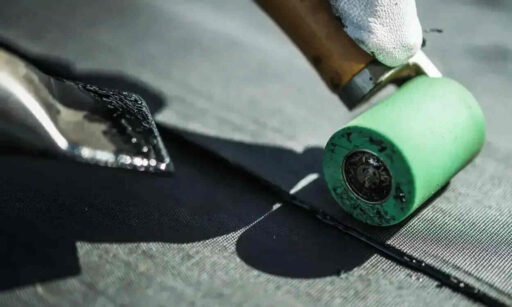
TPO vs. PVC
PVC (polyvinyl chloride) is another plastic-based roofing choice that’s similar to TPO:
- Chemical resistance: PVC has a strong resistance to chemicals, which makes it a great choice for buildings that have grease traps or exhaust issues.
- Fire resistance: TPO and PVC both meet the industry’s fire resistance standards.
- Strength: TPO has more tear and break strength than PVC.
- Cost: TPO tends to be cheaper than PVC, so it’s easier on the wallet.

TPO vs. Modified Bitumen
When comparing TPO to modified bitumen, it’s important to consider both materials’ strengths and weaknesses, especially for flat or low-slope roofs:
- Lifespan: TPO generally lasts longer than modified bitumen, with a typical lifespan of up to 25 years, while modified bitumen often needs replacement after 10–20 years.
- Durability: TPO is more resistant to punctures and tears compared to modified bitumen, making it a tougher option for areas that experience harsh weather.
- Energy Efficiency: White TPO membranes reflect UV rays, helping to reduce cooling costs, whereas modified bitumen typically absorbs more heat, making TPO a better energy-efficient option.
- Installation: TPO is quicker and easier to install due to its single-ply membrane, while modified bitumen requires more time and effort, especially for multilayer applications.
As with any roofing decision, consider your building’s needs, climate, and budget when choosing between TPO and modified bitumen. Both materials have their merits, but the right choice depends on your specific situation.
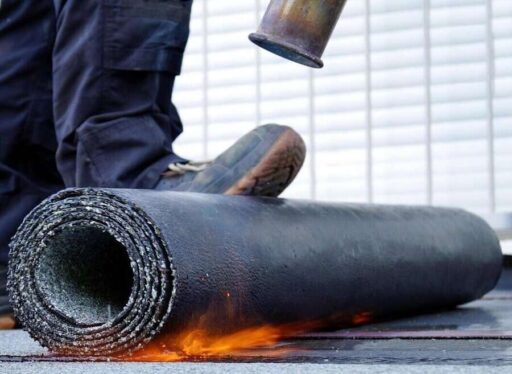
Cost Factors for TPO Roofing
When you’re thinking about TPO roofing for your building, you need to understand what affects the cost. This includes how much the materials cost, what you’ll pay for installation, and how much you might save over time.
Material Costs
- TPO roofing materials cost between $4.86 and $19.43 for each square foot. Roofers often sell TPO in “squares,” where one square covers 100 square feet. This means you could pay between $485.80 and $1943.20 for a square of TPO.
- TPO membranes come in different thicknesses: 45 mils, 60 mils, and 80 mils. Thicker membranes cost more but last longer. A GAF 80-mil TPO full-size roll measures 10 feet by 100 feet, while a half-size roll is 5 feet by 100 feet.
You’ll also need to consider the cost of insulation, which makes up about 25% of the total project cost. Insulation prices range from $2.22 to $20.82 per square foot, based on the type you choose.
Installation Expenses
Labor costs for TPO roof installation range from $4.86 to $7.29 per square foot, or $104.10 to $124.92 per hour. The way you install it has an impact on the total cost:
- Ballasted attachment: $2.08 — $3.47 per square foot
- Fastened roof: $2.78 — $4.16 per square foot
- Attached roof (adhered): $3.82 — $4.86 per square foot
If you need to take off an old roof, plan to spend between $1.39 and $5.55 for each square foot. But if your current roof is in good shape, you might have the option to put TPO on top of it. This would cost you $0.14 to $2.08 per square foot to clean and get ready.
Savings Over Time
- The upfront costs might look big, but TPO roofing can save you money in the long run. It has properties that make it energy-efficient, which can cut down on cooling costs in hotter areas.
- TPO’s white surface bounces back sunlight, which might lower how much energy you use for air conditioning.
- Also, TPO roofs need less upkeep, which can save you money as time goes on. Because TPO lasts so long, you won’t have to fix or replace it often freeing up your maintenance funds for other things.
For a successful TPO roofing installation, it’s essential to hire experienced roofing professionals. A skilled roofing contractor ensures the materials are properly installed, maximizing the lifespan and energy-saving benefits of your TPO roof. Choosing experts for your installation can prevent costly mistakes and ensure your investment lasts for years to come.
Final Thoughts
TPO roofing has changed the roofing industry, offering a mix of toughness, energy savings, and good value. Its makeup and features make it a top choice for flat or sloped roofs, holding its own against options like EPDM, PVC, and mod bit roofing systems. The range of sizes and colors lets homeowners and business owners pick roofing that fits their exact needs and likes. When comparing the advantages and drawbacks of TPO roofing, you need to think about the upfront costs and how much you might save in the long run. The initial price tag can be hefty, but TPO roofing’s energy-saving features and low upkeep needs can help cut down on expenses over time.
